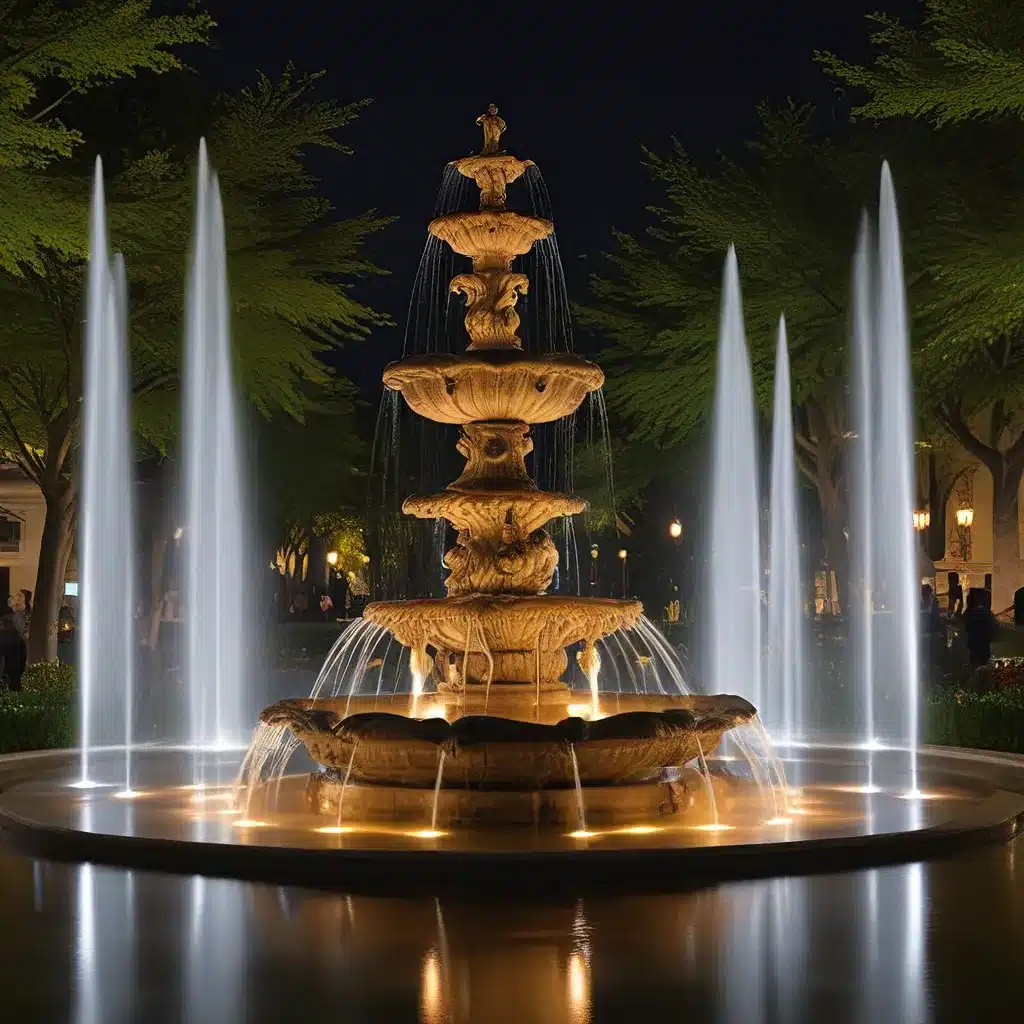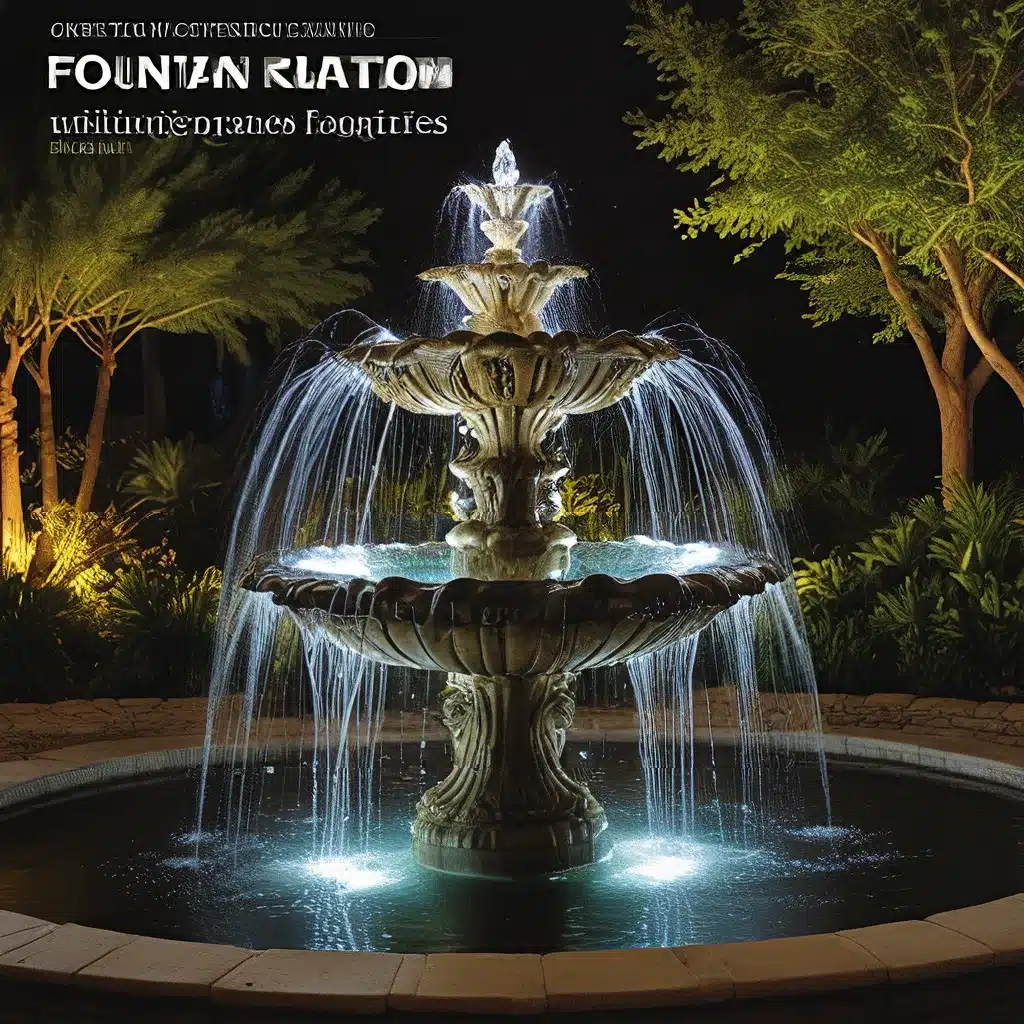
Fountain Design Essentials – Welcome to Fountain Lights
Fountain Design Essentials – Welcome to Fountain Lights

As the sun dips below the horizon, the once serene landscape transforms into a mesmerizing canvas of light and shadow. This is the time when the true magic of fountain lighting begins to unfold, captivating the senses and stirring the soul.
I’ve had the privilege of witnessing this enchanting process firsthand, as I’ve dedicated over three decades to the art of landscape lighting design. From sculpting granite landscapes in the lush tropics of Brazil to mastering the subtleties of Japanese garden traditions, my journey has been one of constant exploration and discovery. And at the heart of it all lies a profound fascination with the power of light to elevate the beauty of water features.
When it comes to fountain lighting, the key is to strike a delicate balance between focal glow and ambient luminescence. The focal glow is what initially draws our attention, the brightest areas that captivate our gaze. The ambient lighting, on the other hand, is the gentle illumination that fills the spaces in between, creating a harmonious backdrop.
As the team at Let It Glow Illumination so eloquently puts it, “When painting a landscape with light, mastering these fundamental techniques is key. From accentuating architectural marvels to delicately tracing pathways with a soft glow, each technique serves to cultivate focal glow and ambient luminescence, breathing life into nighttime living spaces.”
To bring this vision to life, there are a multitude of lighting techniques that can be employed, each with its own unique capabilities and aesthetic appeal. Let’s explore some of the most captivating approaches:
Uplighting, where light fixtures are placed at ground level or below to illuminate objects or architectural features from below, creates a dramatic effect that draws attention to specific elements in the landscape. By aiming the light upwards, uplighting can accentuate the vertical surfaces of fountains, sculptures, or other focal points, adding depth and texture to the outdoor environment.
Highlighting, the technique of accentuating specific features or areas within the landscape by directing focused light onto them, is a powerful tool for drawing the eye to key elements. Whether it’s a towering fountain, a captivating sculpture, or intricate architectural details, highlighting can make these features truly shine.
Cross lighting, the illumination of a subject or object from multiple directions, typically from opposite sides or angles, creates balanced lighting and minimizes harsh shadows. This approach results in a more evenly lit and visually appealing scene, allowing the beauty of the fountain to take center stage.
Wall washing, the technique of positioning light fixtures to illuminate a vertical surface evenly from top to bottom, can be particularly effective for showcasing the texture and architectural features of a fountain’s structure. By creating a soft, uniform illumination, wall washing minimizes harsh shadows and allows the fountain’s details to emerge.
To achieve the captivating effect of shadowing, light fixtures are positioned in front of or below the object being illuminated, aiming the light toward the surface behind it. As the light passes through or around the fountain, it creates shadows that are cast onto nearby surfaces, adding depth, texture, and visual interest to the scene.
Grazing, the technique of placing light fixtures close to a surface and directing the light parallel to it, can accentuate the contours and textures of a fountain’s facade, creating a sense of depth and drama.
Silhouetting involves positioning a light source behind the fountain, effectively blocking direct light from reaching the viewer’s perspective. This backlighting creates a striking contrast between the illuminated background and the dark silhouette of the fountain, resulting in a visually impactful scene.
But the magic of fountain lighting doesn’t stop at the water’s edge. It also extends to the surrounding landscape, guiding visitors through a captivating nighttime journey.
One of the most important techniques in this regard is path lighting, which enhances the safety and visibility of pathways, walkways, and other pedestrian routes within the outdoor space. By strategically arranging path lights, designers can create a visually captivating lighting scheme that invites exploration and enhances the overall experience.
Staggered path lighting, achieved through the creative placement of various path light fixtures, can transform a simple walkway into a mesmerizing work of art. By carefully orchestrating the rhythm and pattern of the illumination, designers can cultivate a sense of depth and intrigue, drawing visitors deeper into the enchanting landscape.
Single-row path lighting, a more straightforward yet equally effective approach, can ensure that pathways are well-lit and inviting, creating a pleasant and enjoyable outdoor experience for residents and visitors alike.
Marker lighting, the use of low-level lights or markers to delineate specific areas or guide pathways, provides subtle illumination without drawing attention away from the surrounding landscape. This technique helps visitors navigate the outdoor space with ease, while maintaining the overall enchantment of the fountain-centered design.
But the magic of fountain lighting doesn’t stop there. By incorporating strategic wall and ledge lighting, designers can further elevate the atmosphere and enhance the overall aesthetic appeal of the outdoor space.
Wall lighting, the strategic placement of light fixtures on vertical surfaces such as walls, fences, or pillars, serves both functional and aesthetic purposes. It enhances visibility, safety, and ambiance, while showcasing the architectural features that frame the captivating water feature.
Ledge lighting, the illumination of horizontal surfaces like ledges, retaining walls, or steps, not only enhances safety but also adds visual interest and highlights the architectural elements that complement the fountain design.
But the true pièce de résistance of fountain lighting lies in the captivating interplay between water and light. As sculptor and landscape artist Frederick L. Gregory eloquently states, “The use of water in my pieces is not something I ever thought about in any direct formal philosophical way. I simply started working with water as part of the whole landscape mix.”
Underwater lighting, the use of fixtures specifically designed to be submerged in water, adds a mesmerizing visual element to fountains and water features. These submersible lights create stunning effects, captivating the senses both during the day and at night.
Mirroring, the strategic placement of light fixtures to create reflections on water surfaces, enhances the visual appeal of fountains by doubling the illuminated area and adding depth and dimension to the landscape.
Refractional lighting, the strategic placement of fixtures near fast-moving water to create a scattered lighting effect, adds an element of captivating movement and energy to the fountain display.
But the magic of fountain lighting doesn’t stop at the water’s edge. It extends to the surrounding landscape, guiding visitors through a captivating nighttime journey. One of the most important techniques in this regard is stair lighting, which enhances the safety and visibility of pathways, walkways, and other pedestrian routes within the outdoor space.
Stair wall lights, typically installed at intervals along the wall parallel to the stairs, offer directional lighting downward onto each step, ensuring visibility and reducing the risk of accidents. These lights come in various designs, allowing for customization to suit different architectural styles and preferences.
Stair step lights, installed directly into the steps or adjacent to them, provide a low-level, diffused light that enhances visibility and safety while adding a decorative element to staircases and pathways. This subtle illumination creates a warm, inviting ambiance without overpowering the overall design.
Stair downlights, fixtures designed to provide illumination downward onto each step of a staircase from above, offer a clean and unobtrusive lighting solution. Recessed into the ceiling or mounted flush with the surface, these lights provide a practical and elegant lighting solution for staircases, enhancing both functionality and aesthetics in indoor and outdoor spaces.
As I reflect on my journey through the world of fountain lighting, I’m struck by the way these techniques and principles can be woven together to create a truly captivating masterpiece. It’s not just about illuminating the water feature itself, but about crafting a cohesive, harmonious landscape that enchants the senses and stirs the soul.
Whether it’s the dramatic uplighting that draws the eye to a towering fountain, the gentle wall washing that showcases its intricate details, or the staggered path lighting that guides visitors on a mesmerizing journey, each element serves to create a symphony of light and shadow.
And just as a great composer weaves together multiple instruments to create a breathtaking symphony, the true magic of fountain lighting lies in the masterful integration of these diverse techniques. It’s a delicate balance, a carefully orchestrated dance of light and water that captivates the senses and leaves a lasting impression on all who behold it.
So as the sun dips below the horizon and the stage is set for the fountain’s nocturnal performance, I can’t help but feel a sense of excitement and anticipation. For this is the moment when the true artistry of fountain lighting takes center stage, transforming the ordinary into the extraordinary and reminding us all of the power of light to elevate the beauty of the natural world.
Share to :
Subscribe to our newsletter for the latest in fountain design, innovative lighting ideas, and exclusive tips straight to your inbox. Join the community shaping the future of water features.

Rapid delivery to your doorstep.

Excellence in every product.

Great value for your investment.

Assistance at any hour.
Fountain Lights — Illuminating creativity in every splash!
Copyright © 2023. All Right Reserved